Have you noticed how many butterflies are out there right now? Literally hundreds! Weather conditions have been just right to produce a bumper crop of several different species.
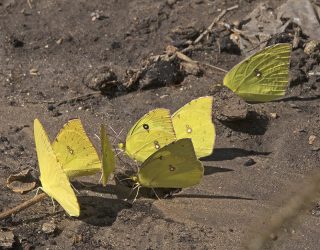
Sometimes all you need is wet ground to bring in the butterflies. This cluster of yellow males is mining much needed minerals from the damp soil of a recently watered rose bed. The one near the center of the group has a black spot on its closed wings. This indicates that it is a Southern Dogface. If it were to fly you could see the “dog’s head” on its open wings. Robert Benson Photo.
14 Oct 2016 – Oodles of Butterflies…But No Monarchs Yet.
Perhaps the most numerous are the Queens. These burnt orange butterflies with the black edgings and white dots are striking, especially “en masse.” Queens are relatives of the famous Monarch Butterflies. Monarchs are a little larger than the Queens and have pronounced black veins on the dorsal sides of their wings. Every morning I go out to the Gregg’s Mistflower bed and look through the dozens of Queens, hoping for a Monarch among them.
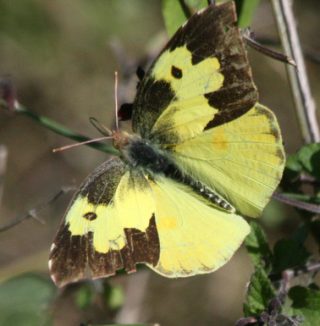
So far, I have not seen a Monarch. At our latitude (28 degrees North) we can expect a few of these migrating butterflies to pass through from October 10th to October 27th. The peak of the wave is due on October 20th according to the monarchwatch.org website. Of course, southwesterly winds can retard the migration and a series of cold fronts can speed it up. So these dates are approximate.
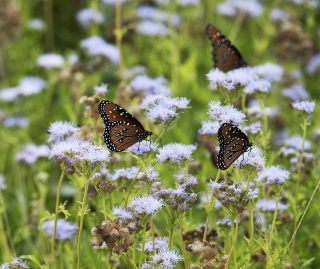
Can there be a better butterfly attractant than Gregg’s Mistflower? It thrives in south Texas and is usually covered with butterflies. It is not unusual for our mistflower beds to host a hundred or more Queen Butterflies from mid-morning to late afternoon. Here three Queens are nectaring on the pretty blue-violet flowers. Robert Benson Photo.
If you look at the website’s map of the fall migration of Monarchs, you will notice that we here in Bee County are not on the main flyways for the butterflies. Most of them travel through central Texas heading south. Another route follows the coast. It seems that we are in a sort of “trough” between the main flyways. Even so, we should get a few strays. Maybe we just need more people watching for the Monarchs here in the “trough.”
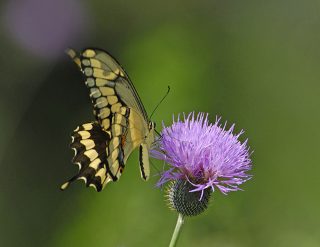
Giant Swallowtails are really big and easy to identify. They range throughout eastern North America, west to the Rocky Mountains, and to South America. You can expect to see these beauties all year round in our area. Robert Benson Photo.
The trick is to concentrate the butterflies in a small area so they are easier to examine and identify. Fall-blooming flowers are one of the easiest ways to attract butterflies of all types. Gayfeather (Liatris sp.), Crucita and Frostweed are nectar-rich natives in bloom right now. Gregg’s Mistflower is a butterfly garden mainstay. Mistflower is easy to grow and will bloom almost year round. All it requires is a little shearing of the spent blossoms several times a year to keep it looking good and appealing to insects.
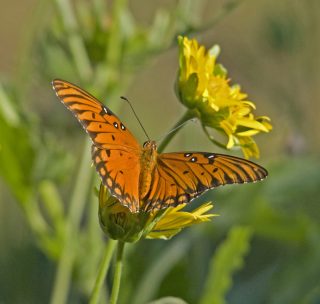
Gulf Fritillaries are dazzling beauties of the southern regions of North America. They are drawn to flowers of all types but are especially attracted to passionvine. Robert Benson Photo.
Recently, Al Past showed me a photo he took of a gathering of Large Orange Sulfur Butterflies…on the ground! You too may have witnessed something like this on moist sand or pond edges. The behavior is called “puddling.” Butterflies amass on damp soil not so much to get liquid but to ingest minerals dissolved in the water. Studies show that the males of the species are the ones doing the puddling. They need the extra minerals and amino acids to produce pheromones and viable sperm. Sometimes just watering your garden will make temporary puddling locations. The Internet has recipes to increase the mineral content of a puddle. Stale beer, compost, and rotting fruit figure largely in most of the recipes.
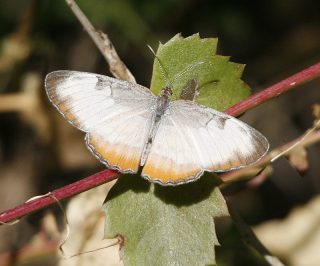
These medium-sized jewels are gray-white to light brown. Their hindwings have an orange marginal band that easy to see while they are flying. Common Mestras are abundant in south Texas. Robert Benson Photo.
I dampened a patch of mesquite bean and leaf litter by accident lately. Within minutes, a dozen yellow butterflies arrived. I think the decomposing mesquite beans released a lot of proteins and amino acids. There were at least four different sizes of butterflies, mostly yellow in color. The coolest one was a Southern Dogface. This species closes its wings when it lands. The closed wings appear all yellow. The black on the dorsal wing surfaces is visible only when the butterfly flies. Each forewing has a yellow dog’s profile outlined in black when the wings are opened. A black spot in just the right location resembles the dog’s eye.
From Giant Swallowtails to tiny Little Blues, from Large Orange Sulfurs to the diminutive Dainty Sulfurs, and from Queens to Dogfaces, we are enjoying a bonanza of butterflies right now. There are easily 20 different species nectaring and puddling in our yards and gardens. Take a walk outside on one of these fine fall days and see how many you can find!
If you would like to offer comments, please click through to the discussion page
